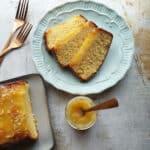Butterscotch Pineapple Upside Down Cake
This butterscotch pineapple upside down cake is baked in a loaf pan, then flipped over and drizzled with a rich and creamy butterscotch sauce.
Ingredients
For the cake
- 3 rings / slices canned or fresh pineapple
- 2 Tablespoons melted butter
- 2 Tablespoons brown or white granulated sugar
- 3 large egg yolks (see note 1)
- 3 large egg whites
- ¾ cup white granulated sugar
- ⅓ cup canned or fresh pineapple juice (see note 2)
- 1 teaspoon vanilla extract
- 1 cup all purpose or cake flour
- 1 teaspoon baking powder (DO NOT USE baking soda/bicarbonate of soda)
- ⅛ teaspoon salt (about a pinch of salt)
For the butterscotch sauce
- ¼ cup butter
- ½ cup brown sugar (see note 3)
- ½ cup heavy / whipping cream
- ¼ teaspoon salt
- ½ teaspoon vanilla extract (optional)
Instructions
- Preheat the oven to 350°F /180°C ( 160°C fan oven). Line an 8x4 inch (20x10 cm) loaf pan with parchment (baking paper).
- Add melted butter to the loaf pan, leaving it to puddle evenly at the bottom. Sprinkle evenly with the brown sugar and then arrange the pineapple slices in a single layer on top of the sugar. Set aside.
Egg yolk mixture
- In a large bowl, beat the egg yolks until pale in color and thick (this should take about one to two minutes when using an electric beater on medium speed
- Gradually add sugar, beating well. Add the vanilla extract and pineapple juice and mix to combine.
- Sift the flour, baking powder and salt into the batter and beat until combined and set aside.
Egg whites
- Rinse the batter mixture off the beaters. In a separate large bowl using the clean beaters, beat the egg whites to form firm peaks. (This should take about 2 to 3 minutes when using an electric beater on medium high speed. (See note 4)
Combine egg yolk mixture and beaten egg whites
- Use a spatula to gently fold the beaten egg whites into the egg yolk mixture combining to form a smooth batter
Bake
- Pour the batter into the loaf pan and carefully spread to the edges of the pan.
- Bake for 30 to 35 minutes. You may want to cover lightly with foil after 20 minutes into the baking time if the cake is browning too quickly. (Shape the foil into a dome, so that it does not touch the top of the cake as it bakes)
- The cake is baked when a toothpick inserted into the center comes out with a few sticky crumbs. (no runny batter)
- Cool the cake in the pan for 10 minutes.
- Place either a cooling rack, cake plate or stand over the top of the cake and carefully turn it out of the pan and onto the plate.
Make the butterscotch sauce
- Melt butter in a medium heavy-bottomed saucepan over medium heat.
- Once the butter has melted, add the brown sugar and a pinch of salt. Whisk for about 10 seconds to combine
- Then pour in the heavy cream. Whisk occasionally, while bringing to a gentle bubble for about 5 - 10 minutes.
- Take the pan off the heat and stir in the vanilla extract (if using)
- The butterscotch sauce will thicken as it cools.
- Drizzle the butterscotch sauce over the still warm cake.
- Sprinkle with crushed nuts like walnuts, pecans or pistachio nuts if you like.
- You can save any remaining butterscotch to serve with slices of the cake.
- The butterscotch may turn grainy as it cools. To fix this, simply reheat for a few seconds in the microwave or stovetop until smooth and pourable again.
Storage
- Store the cake plain or drizzled with the butterscotch at room temperature : - in an airtight container for up to 3 days or - in the refrigerator for up to one week
Notes
1.Why do we need to beat the egg yolks and whites separately?
- When eggs are separated, the yolks and whites serve different purposes in baking.
- Yolks add richness to a batter, while the egg whites act as a natural leavening agent producing a fluffy soft textured cake.
- If the eggs are not separated, their only function will be as a binding agent, which can produce a denser and heavier texture.
- That is why it's important to beat the yolks and whites separately ensuring their properties are used to their full potential, for a cake that has both rich flavor and a fluffy, soft texture.
- First, slice the 3 rings of pineapple (for arranging at the bottom of the cake pan)
- Cut the remainder of the pineapple into a few chunks (about 1 cup, roughly chopped).
- Puree the chunks in either a blender or food processor or (electric juicer, if you have one)
- Then strain the mixture through a fine mesh sieve or cheesecloth until you've collected ⅓ cup (80ml) of the juice.
- You can now use the fresh juice you strained instead of the canned pineapple juice in the recipe.
- Caramel starts with white sugar, while butterscotch is made using brown sugar.
- Heating the brown sugar releases the sweet, nutty, molasses flavor creating the most decadent, indulgent butterscotch flavors.
- Using brown sugar instead of regular white sugar takes this sauce to a whole new level of deliciousness and much easier than making caramel sauce.
Tried this recipe?Mention @thegardeningfoodie or tag #thegardeningfoodie!
